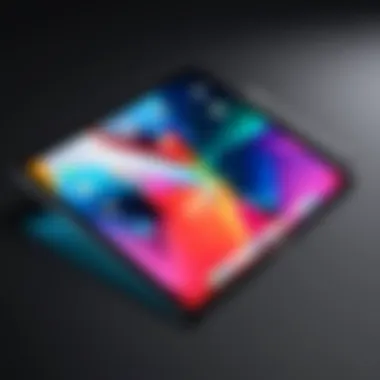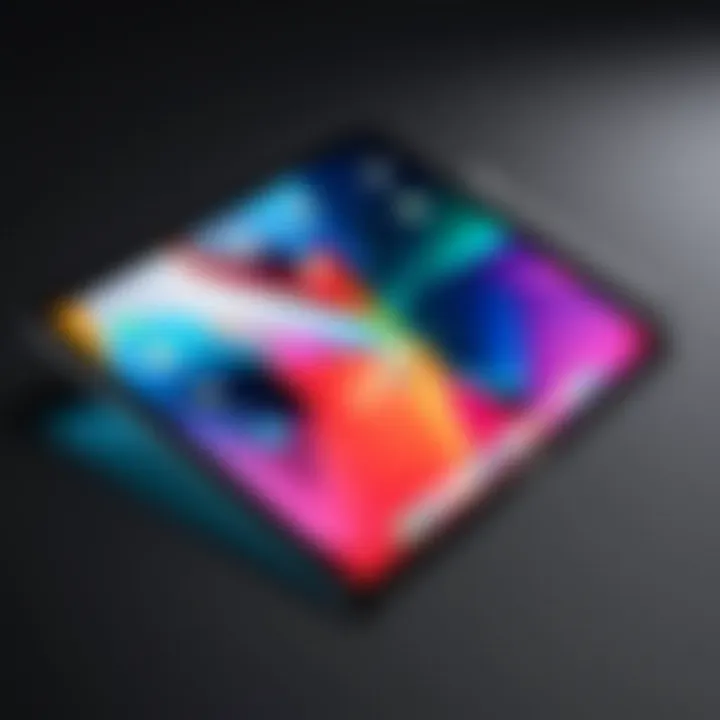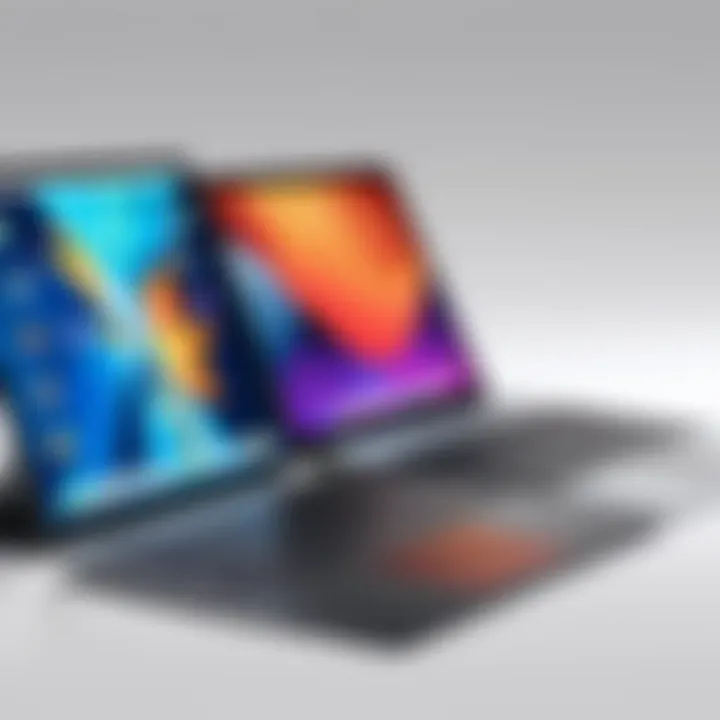iPad Pro vs MacBook Pro: Choose Wisely for Your Needs


Intro
The landscape of personal technology is vast and varied. Choosing between the iPad Pro and the MacBook Pro reflects not just preferences but also specific use cases. Each device brings unique strengths to the table, aiming to cater to distinct segments of users. Understanding these distinctions is essential for tech-savvy individuals who wish to make informed decisions.
This article aims to dissect the fundamental aspects of both devices, from design to performance, ultimately guiding you in selecting the technology that aligns best with your needs.
Overview of the Technology
In this section, we will contrast key specifications and the unique selling points that both the iPad Pro and MacBook Pro bring to the fore.
Key specifications
iPad Pro
- Display: Liquid Retina display with ProMotion technology, providing a refresh rate up to 120Hz.
- Processor: Apple M1 chip, offering powerful performance for applications and multitasking.
- Storage Options: Ranges from 128GB to 2TB, accommodating various user needs.
- Connectivity: USB-C with Thunderbolt support and optional 5G capabilities.
MacBook Pro
- Display: Retina display available in various sizes, featuring True Tone technology.
- Processor: Apple M1 chip or M1 Pro chip, supporting demanding creative tasks and workflows.
- Storage Options: From 256GB to 8TB, ideal for professionals needing substantial storage.
- Connectivity: Multiple Thunderbolt ports and MagSafe power connector, enhancing flexibility.
Unique selling points
The iPad Pro excels in portability and touch interface, making it ideal for on-the-go tasks. Its versatility as both a tablet and a laptop replacement is noteworthy, especially with the Apple Pencil and Magic Keyboard.
On the other hand, the MacBook Pro provides a full desktop experience, featuring a traditional keyboard and larger screen. This device is better suited for developers, designers, and other professionals who require an OS optimized for productivity.
Design and Build Quality
Design plays a significant role in choosing between these devices. Aesthetics, material used, and usability all contribute to user satisfaction.
Material used
The iPad Pro is constructed from a sleek aluminum unibody, contributing to its lightweight nature. Its design is minimalistic, making it visually appealing.
The MacBook Pro also features a sturdy aluminum body but comes with added heft. The slightly thicker design is often justified by its powerful performance features and battery life.
Ergonomics and usability
When it comes to ergonomics, the iPad Pro offers an intuitive touch interface. However, prolonged use may demand additional accessories like a keyboard and screen protector for comfort.
The MacBook Pro is designed for longer sessions. The keyboard is tactile with a satisfying travel distance, making typing more comfortable over extended periods.
"Choosing the right device often comes down to understanding your specific needs and workflow."
Closure
Understanding the crucial differences between the iPad Pro and MacBook Pro is essential for making an informed decision in today's evolving tech landscape. As devices become increasingly versatile, knowing the strengths of each can better equip users in their technology choices.
Prelude
In the current landscape of portable computing, the choice between the iPad Pro and MacBook Pro has become more complex. Each device offers unique features tailored to different user preferences and needs. Understanding these distinctions is essential for anyone contemplating a purchase.
The iPad Pro showcases versatility through its touchscreen interface, making it appealing for creative tasks such as drawing and design. It also offers portability and ease of use for casual browsing and media consumption. In contrast, the MacBook Pro positions itself as a powerhouse, equipped with a full keyboard and macOS capabilities, ideal for intense productivity tasks, software development, and content creation.
Evaluating these devices requires consideration of various elements, including design, performance, software ecosystem, and user experience. This analysis aims to shed light on how these factors cater to different audiences, be it students, professionals, or tech enthusiasts.
A deeper understanding of both devices empowers potential buyers to make informed decisions, tailored to their specific use cases and preferences. By diving into this comparison, readers will gain insights that clarify the strengths and weaknesses of each device, ultimately guiding them toward the optimal choice for their lifestyle.
"Understanding the core differences can significantly alter your computing experience and productivity."
Overview of iPad Pro
The iPad Pro represents a shift in how users engage with technology, combining functionality and portability. It is essential to understand its various components when contrasting it with the MacBook Pro. Factors like design, performance, and usability can play a pivotal role in meeting a user’s needs. A detailed examination allows tech consumers to make informed choices based on features and intended use.
Design and Aesthetics
The design of the iPad Pro is sleek and modern. It is incredibly thin and lightweight, making it easy to carry. The aluminum body contributes to its premium feel. The bezels are minimized, enhancing the overall appearance. Additionally, the device is available in different colors, appealing to a wider audience.
The absence of a physical keyboard makes it unique, giving it a distinct look compared to traditional laptops. However, it can interface with accessories such as the Magic Keyboard, transforming it into a more hybrid experience between tablet and laptop.


Display Technology
Display technology is crucial for user experience. The iPad Pro features a Liquid Retina XDR display, delivering bright colors and high contrast. It is equipped with ProMotion technology, offering a refresh rate of up to 120Hz. This makes for a smoother visual experience, particularly for tasks involving graphics and motion.
The high resolution of the display enhances the clarity of images and texts, making it suitable for graphic design and media consumption. Such display capabilities are significant when contrasting iPad Pro’s suitability for creative tasks versus more traditional computing needs.
Performance Capabilities
Performance is vital in determining how well a device meets user demands. The iPad Pro is powered by the M1 chip, which significantly boosts speed and efficiency. This performance level means that multitasking can happen seamlessly. Users can run demanding applications without a noticeable lag.
In terms of graphics processing, the iPad Pro excels, making it an excellent option for designers, video editors, and gamers. The capability to work on graphics-intensive tasks while on the go is one of its key benefits. Overall, its performance capabilities are designed to cater to a wide range of users, from casual to power users.
Overview of MacBook Pro
In the ongoing exploration of mobile computing options, the MacBook Pro stands out for its significant contributions to productivity and user experience. Understanding this device is important for tech enthusiasts and consumers seeking a device that blends power with versatility. This section emphasizes key attributes of the MacBook Pro, clarifying considerations such as design, performance, and its suitability for various tasks.
Design and Build Quality
The MacBook Pro features a refined design characterized by aluminum construction, giving it a premium feel and enhanced durability. This laptop is available in several sizes, allowing users to choose according to their preferences. Its sleek lines and minimalistic design not only provide aesthetic appeal but also contribute to its ergonomic usability.
User feedback often points out how the weight distribution of the MacBook Pro enhances comfort, whether used on a desk or lap. The keyboard, for instance, demonstrates careful engineering to enable typing efficiency with sufficient feedback. The larger trackpad also supports multitasking and gestures, improving overall user interaction.
Screen and Display Options
The display options of the MacBook Pro are tailored for both creatives and professionals. Users can select from Retina displays that support vibrant colors and high resolutions. The larger models offer higher brightness levels, enhancing visuals for graphic design, video editing, and photo work.
Moreover, the True Tone technology adjusts the white balance depending on the environment, which provides a more natural viewing experience. Many users appreciate this feature, particularly in work environments where lighting conditions vary. This capability can reduce eye strain during long usage periods, making it a beneficial aspect for those engaged in extensive screen time.
Processor and Performance
At the heart of the MacBook Pro lies its powerful processor configurations. Users can opt for Apple’s M1 or M2 chips, designed to provide impressive speed and efficiency. This transition to Apple silicon marked a significant shift in computing, as these processors offer remarkable performance for demanding applications.
Thanks to the unified memory architecture, the MacBook Pro can handle intensive tasks such as 4K video editing and software development seamlessly. Users who multitask often find that the performance remains consistent, with minimal lag. For tech enthusiasts, understanding the implications of processor choice is critical, as it directly influences both performance and battery life.
In summary, the MacBook Pro presents strong design and performance attributes that cater to a varied audience. From creative professionals to students, its features offer something for everyone, making it a formidable contender in the realm of portable computers.
Operating Systems Comparison
The operating systems of the iPad Pro and MacBook Pro significantly influence user experience, application compatibility, and overall performance. Understanding these systems is crucial for potential buyers as it highlights the strengths and weaknesses of each device in real-world scenarios. An effective operating system enhances user productivity, streamlines workflow, and ultimately shapes how the device serves its user. This comparison focuses on the unique features and advantages of iPadOS and macOS, aiding readers in making informed choices about their intended use and personal preferences.
iPadOS Features
iPadOS offers a range of features specifically tailored for touch interface. It balances performance and usability, making it attractive for a variety of users. Some important aspects include:
- Multitasking Capabilities: iPadOS supports Split View and Slide Over, enabling users to run multiple applications simultaneously. This can increase efficiency, especially in creative tasks where cross-application functionality is essential.
- Apple Pencil Integration: Users can leverage the precision and sensitivity of Apple Pencil for tasks such as note-taking, drawing, or editing. This feature is invaluable for artists and designers.
- App Ecosystem: iPadOS provides accessibility to a vast library of optimized applications. Many popular productivity apps and creative tools adapt well to the iPad's interface, offering a smooth experience.
Additionally, iPadOS receives regular updates, introducing features that enhance its functionality over time. The seamless integration with other Apple services adds another layer of convenience.
macOS Capabilities
macOS, on the other hand, brings a robust desktop experience. It is an established operating system that caters to power users and professionals. Key features include:
- File Management System: macOS offers advanced file organization tools such as Finder and Spotlight. This system allows users to quickly search and retrieve files, optimizing daily tasks.
- Software Compatibility: The operating system supports a wider range of software, especially professional-grade applications. This includes comprehensive tools for video editing, programming, and graphic design, which tend to operate more efficiently on macOS.
- User Interface: The desktop-oriented design allows for more complex workflows. Users can customize their workspace with multiple desktops and a variety of window management options.
- Integration with Apple Ecosystem: Features like Handoff, Continuity, and universal clipboard facilitate smooth transitions between devices, making macOS an appealing option for users who own multiple Apple devices.
In sum, the choice between iPadOS and macOS ultimately hinges on individual needs and preferences. Each system has unique strengths that cater to different user requirements.
Software Ecosystem
The software ecosystem surrounding any device is crucial. It determines the functionalities, user engagement, and, ultimately, the overall value a device brings to its owner. In the context of the iPad Pro and MacBook Pro, understanding this ecosystem helps prospective buyers navigate the features and limitations of each device.
Applications and Compatibility
Both iPad Pro and MacBook Pro offer a wide range of applications suited for various user needs. The iPad Pro primarily runs on iPadOS, which hosts numerous applications designed specifically for its touch interface. These apps range from creative tools like Procreate and Affinity Designer to productivity options such as Notability and Microsoft Word. Furthermore, the compatibility with the Apple Pencil enhances drawing and writing capabilities, making it appealing for designers and students alike.
On the other hand, MacBook Pro operates on macOS, an operating system that supports a larger library of software, particularly in certain professional fields. Software such as Adobe Photoshop, Final Cut Pro, and various code editors perform optimally on macOS, offering extensive functionalities. Users who rely on specialized software may find that the MacBook Pro meets their needs better than the iPad Pro due to this compatibility.
"Choosing between iPad Pro and MacBook Pro often hinges on specific application requirements."
This differentiation in applications is vital for users who may need specific software for their work or hobbies. While both platforms have overlapping applications, the depth and nature of these apps can impact user experience significantly.


Productivity Tools and Features
Both devices excel in productivity, but they approach it from different angles. iPad Pro emphasizes touch and pen input, allowing for a more intuitive interaction with apps designed for sketching, painting, or note-taking. Apple's productivity suite, including Pages, Numbers, and Keynote, also integrates seamlessly. iPadOS features like Split View and Slide Over enhance multitasking, making it efficient for users who prefer a more app-centric workflow.
Conversely, the MacBook Pro shines in traditional productivity scenarios. Its keyboard and trackpad experience offers comfort and precision for tasks like writing reports or coding. macOS provides a robust multitasking environment, where users can easily switch between multiple applications with ease. The advanced features such as Mission Control and Resizing Splits have a significant impact on how users manage their workflow.
In summary, understanding the software ecosystem is essential for discerning tech-savvy individuals, gadget lovers, and early adopters. It serves as a guide to assessing how well each device aligns with their specific needs and preferences.
Portability and Battery Life
When choosing between the iPad Pro and the MacBook Pro, portability and battery life are significant factors to consider. Both devices are tailored for users who value mobility, but they achieve this in different ways. Understanding how each device performs in these areas can help users make better decisions based on their unique lifestyles and needs.
Weight and Dimensions
The dimensions and weight of a device play a crucial role in its portability. The iPad Pro is notably lighter and thinner than the MacBook Pro. The standard model weighs approximately 1.5 pounds and boasts a slim profile, allowing it to easily fit into a backpack or even a larger handbag. In contrast, the MacBook Pro weighs around 3 to 4 pounds, depending on the model and size, making it bulkier.
While the MacBook Pro provides a sturdy build, its larger form factor may not suit users who are constantly on the go. Prepared for meetings or classes, a user may find that the iPad Pro's lightweight and compact design offers easier handling, especially when used in a variety of settings like cafes, public transport, or even walking.
Battery Performance
Battery life is another essential aspect of portability. Users need a device that can last through long working hours or travel days without frequent recharging. The iPad Pro generally offers impressive battery life, often exceeding 10 hours of active use. This makes it an attractive option for users who require a device that can keep up with a busy day.
On the other hand, the MacBook Pro's battery life also ranges around 10 to 12 hours, varying by usage and model. It can support demanding applications better because of its robust hardware and larger battery capacity, but the high-performance usage may lead to quicker drainage.
Both devices support fast charging. However, users should remember that while both options can last a full day of typical use, actual performance may depend on the specific tasks being performed. Power-intensive tasks like video editing or gaming can drain batteries significantly faster.
"Portability and battery life are not just specs; they define how a device fits into your lifestyle."
Input and Interaction
Input and interaction are critical elements in determining how effectively a user can engage with their devices. For both the iPad Pro and MacBook Pro, these aspects heavily influence the overall usability and user experience. Understanding how each device facilitates interaction helps users recognize which is more suited to their workflow and preferences. Touch capabilities, pen support, keyboard functionality, and trackpad responsiveness dramatically affect productivity and creativity.
Touch and Pen Support on iPad Pro
The iPad Pro stands out with its robust touch capabilities and support for the Apple Pencil. This device allows for intuitive navigation through touch gestures. Users can swipe, pinch, and tap with great ease. For creative individuals, the Apple Pencil provides a precision that makes drawing and designing feel natural. With features like low latency and pressure sensitivity, artists and designers can achieve intricate details in their work.
Overall, the iPad’s touch display is responsive and offers a fluid experience that suits both casual use and more intensive creative tasks. Additionally, the ability to write notes directly on the screen can enhance learning and retention for students and professionals alike. Notably, the iPadOS has been tailored to support these interactions, including various apps designed to maximize the potential of the touch interface.
Keyboard and Trackpad Experience on MacBook Pro
In contrast, the MacBook Pro emphasizes the traditional laptop experience with a focus on keyboard and trackpad interaction. The key travel and feedback of the MacBook Pro's keyboard are designed for comfort during extended typing sessions. Users can find themselves working efficiently on documents, emails, or programming code without experiencing fatigue. The touch bar on some models offers context-sensitive controls, improving workflow by providing shortcuts where needed.
The trackpad, known for its size and sensitivity, allows for smooth navigation without reliance on touchscreen capabilities. Gestures such as swiping and pinching are recognized instantly, streamlining multitasking and application switching. These features position the MacBook Pro as a powerful tool for professional environments where extensive typing and precise control are paramount.
In essence, the choice between iPad Pro's touch and pen capabilities and MacBook Pro's keyboard and trackpad experience often depends on the user's unique needs.
Both input methods accommodate diverse tasks. The iPad Pro excels in creative contexts, while the MacBook Pro appeals to those focused on productivity and traditional computing. Understanding these differences can help users decide which device aligns more closely with their expectations and workflow.
Price Considerations
When evaluating the iPad Pro and MacBook Pro, the price considerations present significant implications for potential buyers. Understanding these financial aspects can help individuals and businesses make more sound decisions based on their requirements and budget constraints. Both devices cater to distinct markets, and their pricing reflects the features and capabilities offered. Thus, it is critical to assess not only the upfront costs but also the long-term value and potential return on investment.
Initial Investment for iPad Pro
The initial investment for the iPad Pro varies widely depending on the model, storage options, and additional accessories such as the Apple Pencil and Magic Keyboard. At face value, the iPad Pro often appears less expensive compared to a fully equipped MacBook Pro. However, when one considers the necessary accessories for a complete user experience, the total cost can rise significantly.
For instance, the base model of the iPad Pro is competitively priced, but adding essential items can escalate the cost. Here are key factors to consider:
- Base Price: The cost starts at a certain price point but increases with storage capacity.
- Accessories: Accessories like keyboards and styluses add to the overall expense. A good keyboard can cost around $300, while the Apple Pencil can be around $130.
- Software: While choices for apps are plentiful on the App Store, some high-end applications may require additional purchases.
Cost Analysis of MacBook Pro
Price for the MacBook Pro tends to be at the higher end of the spectrum compared to its competitor. This higher investment is justified by its advanced specifications and performance level. MacBook Pro models generally come with more robust hardware, allowing for tasks that go beyond what an iPad Pro can handle efficiently. Here are aspects of cost that are worth analyzing:
- Starting Price: The entry model starts at a higher cost than the iPad Pro, but this reflects its capabilities.
- Configurations: The MacBook Pro offers multiple configurations including processor upgrades, more RAM, and higher storage options, which can exponentially increase the base price.
- Long-Term Value: Given the productivity features and build quality, the MacBook Pro often has a longer usable lifespan, providing added value in the long run.
Overall, buyers should not only consider the initial cost but also how each device will integrate into their daily activities and whether that investment aligns with their future needs. In a rapidly changing tech landscape, understanding the full scope of costs involved aids in making a wiser purchasing decision.
Use Cases and Target Audience


Choosing between the iPad Pro and the MacBook Pro requires an understanding of what types of users will benefit most from each device. Each has its unique strengths and weaknesses, and knowing the target audience helps inform wiser purchasing decisions. This section delves into various segments of users, offering insights into how each device caters to their specific needs.
Creative Professionals and Artists
For creative professionals, such as graphic designers, illustrators, and video editors, both devices have important features but excel in different areas. The iPad Pro, particularly with the Apple Pencil, offers a tactile interface that many artists find intuitive. The display's sharpness and color accuracy enhance creative work, making it easier to produce compelling visuals.
Additionally, applications like Procreate and Adobe Fresco are optimized for touch and pen input, allowing for a seamless creative experience. Thus, the iPad Pro is a tool that promotes artistic expression through portable design.
On the other hand, MacBook Pro appeals to professionals who require robust software for tasks such as film editing or 3D modeling. It supports more extensive applications like Adobe Premiere Pro or Final Cut Pro, which need more processing power and RAM. The keyboard and larger display size foster an efficient working environment for prolonged tasks.
Students and Educators
In the realm of education, both the iPad Pro and MacBook Pro serve distinct educational needs. Students often prioritize portability and battery life, making the iPad Pro an attractive option. The lightweight design makes it easy to transport between classes. With applications available for note-taking, reading, and drawing, the iPad Pro provides versatile functionality.
For educators, the iPad Pro can function effectively as an interactive teaching tool. Apps like Explain Everything and Keynote allow for dynamic presentations and collaborative projects. Its touch interface encourages engagement, keeping students involved during lessons.
However, for students in disciplines like computer science or engineering, the MacBook Pro might be more suitable due to programming software compatibility. Its powerful hardware allows for the use of complex coding environments and multitasking with various software applications, aligning with a more traditional approach to learning.
Business and Professional Use
In a business context, the choice between the iPad Pro and MacBook Pro often comes down to the type of work being performed. The MacBook Pro is tailored to professional needs through its powerful performance and range of software options. Users in finance or programming can rely on its robust capabilities for data analysis or development.
Its extensive port selection allows connection to various peripherals, making it a go-to device for professionals who require versatility in their hardware setup. Also, multi-window support in macOS enhances productivity, allowing users to work with multiple applications simultaneously.
Conversely, the iPad Pro can excel in client-facing roles or creative industries where presentations and light computing are common. The smooth operation of video conferencing apps like Zoom combined with a lightweight design allows for efficient presentations and meetings.
"Understanding your specific needs is crucial when comparing iPad Pro and MacBook Pro. The right choice greatly enhances productivity."
Future of Portable Computing
In today's technology-driven society, the evolution of portable computing has significant implications on how individuals interact with devices like the iPad Pro and MacBook Pro. The rise of mobile computing influences not only personal productivity but also how businesses operate on a day-to-day basis. Understanding the future of portable computing provides insights into the merging of functionality and portability, a combination that users increasingly find essential.
The Significance of Adaptability
As technology progresses, adaptability is key for users. Portable devices must cater to various needs, from professional work to creative endeavors. The iPad Pro, with its focus on touch interaction and lightweight design, appeals more to users who prefer flexibility. The MacBook Pro, however, offers a more traditional computing experience, essential for tasks requiring substantial processing power. As both devices improve, the lines between their functionalities begin to blur, giving users a greater range of choices.
Innovations in Hardware
With each new release, both Apple devices showcase rapid advancements in hardware. The iPad Pro benefits from the M1 chip, providing exceptional speed and efficiency typically seen in laptops. Meanwhile, the MacBook Pro remains a powerhouse for intensive software applications. Future iterations are likely to enhance these capabilities further, providing a richer user experience whether for gaming, design, or business.
Shifting Software Landscapes
Both iPadOS and macOS continue to evolve, with Apple emphasizing cross-compatibility. Users prefer software ecosystems that allow seamless transitions between devices. Features like universal control and AirDrop facilitate smoother workflows. The future may hold deeper integrations, making it easier to switch between the iPad Pro and MacBook Pro without sacrificing productivity.
Considerations for Users
As consumers ponder their next tech purchase, there are multiple factors that may shape their decisions:
- Purpose of Use: Users should clarify whether they prioritize artistic tasks and mobility or heavy computational needs.
- Budget Allowance: Cost plays a significant role in decision-making. The shifting prices of newer models can affect consumer choices.
- Personal Preference: Some users may prefer a keyboard for typing while others might enjoy the touch-screen interface.
"In the world of portable computing, one size does not fit all. Understanding future developments helps users make informed decisions."
Finale
The future of portable computing offers many possibilities. As iPad Pro and MacBook Pro develop, the story of functionality and portability intertwines. The benefits, considerations, and shifts in user needs will dictate advancements. Consumers who stay informed will better navigate their choices in the ever-evolving tech landscape.
Closure
In examining the comparison between the iPad Pro and the MacBook Pro, it becomes clear that each device has its own merits and limitations. This conclusion aims to synthesize the entire discussion, focusing on several vital elements that potential buyers should consider before making their decision.
The primary consideration revolves around the intended use of each device. The iPad Pro, with its touch interface and portable design, is highly suitable for users who prioritize mobility and casual usage. This makes it ideal for artists, casual gamers, and individuals who engage in note-taking or drawing.
On the other hand, the MacBook Pro stands out for tasks that require extensive computing power and robust software capabilities. This device is optimal for professionals who need to perform advanced functions like video editing, software development, or heavy data analysis.
Considerations to keep in mind include:
- Performance Needs: Evaluate whether the power of a MacBook Pro is necessary for your tasks, or if the iPad Pro is sufficient.
- Portability Requirements: Consider how often you need to move your device. iPad Pro is easier to carry around.
- Software Ecosystem: Assess the software applications you commonly use. Are they optimized for iPadOS, or do they require macOS?
The longevity and update support of both devices also play significant roles. Apple tends to support its devices with software updates for several years, which helps maintain their value and functionality.
Ultimately, making the right choice involves assessing personal needs, preferences, and the workflow environment. With this comprehensive understanding, individuals can make decisions that align with their technological requirements. Whether a buyer chooses the innovative iPad Pro or the powerful MacBook Pro, the choice should reflect their unique lifestyle and professional demands.
"Choosing the right device often defines how effectively and efficiently one can work in their field of choice."
Careful reflection on these aspects will significantly enhance the purchasing experience, ensuring satisfaction with the decision made.







